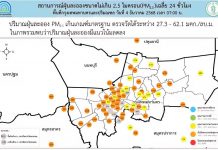On the occasion of Global Tiger Day on July 29th, the Department of National Parks, Wildlife and Plant Conservation (DNP) is trying to raise awareness about the reducing number of tigers in Thailand, saying it wants to increase the tiger population by 50% by 2022.
The Wildlife Conservation Office under the Department of National Parks, Wildlife and Plant Conservation (DNP) recently held a seminar to hear the progress of tiger conservation projects. DNP Deputy Director-General Theerapat Prayurasiddhi said at the meeting that the number of tigers has dropped dramatically. It is estimated that there are only 200-250 wild tigers in Thailand. The department is aiming to see 125 more tigers in the wild by 2022 or ten years from now.

Mr Theerapat said his department will develop the Huai Kha Khaeng-Thung Yai Naresuan Wildlife Sanctuary by introducing a qualitative approach in official patrols and increasing the number of patrolling officers to match the size of forest areas under their responsibility. He added by 2022, 100 more forest protection units will be established in tiger reserve zones.
In addition, the DNP reported that over 1,300 tigers are being raised in government and private zoos, as well as wildlife breeding stations. The department has been collecting data of each tiger to be able to identify the animals and prevent their smuggling . The DNP deputy chief said Thailand has the most complete data on both wild and caged tigers.
A wildlife researcher from the Huai Kha Khaeng Wildlife Sanctuary in Uthai Thani Province reported that since 2005, his team has found 125 tigers in the Huai Kha Khaeng-Thung Yai Naresuan Wildlife Sanctuary.
Meanwhile, 11 more tigers are found in Mae Wong and Khlong Lan National Parks in Kamphaeng Phet. It is believed that more tigers can be found in other national parks of Thailand.
According to the World Wildlife Fund (WWF), tigers are on top of the food chain. Its existence helps control the number of herbivores in the ecosystem. The giant predators need a habitat that contains enough water and prey animals. Fully grown tigers need around 6-7 kilograms of food per day. Over the past century, the tiger population has been decreasing drastically, affecting the ecosystem.
Tiger poaching and the reduction of their prey are the main threats for their existence. Tigers are barely seen in neighbors such as Cambodia, Laos, and Myanmar. While only around 200 are in Thai forests, it is important to help conserve the animal now before it becomes extinct.




